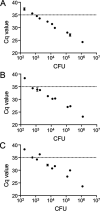Detection of Salmonella Typhi in Bile by Quantitative Real-Time PCR
- PMID: 35639002
- PMCID: PMC9241738
- DOI: 10.1128/spectrum.00249-22
Detection of Salmonella Typhi in Bile by Quantitative Real-Time PCR
Abstract
In countries where the incidence of typhoid fever is high, fecal material from short-term carriers of Salmonella Typhi contaminates inadequately treated water supplies. As treated water supplies and improved sanitation become available, chronic (mainly gallbladder) carriers of S. Typhi become important. The objective of this study was to develop a method for detection of S. Typhi in bile by quantitative real-time PCR (qPCR) in patients undergoing cholecystectomy. We evaluated sensitivity and specificity of probesets that target oriC, viaB, fliC-d, STY0201, and stoD. We optimized DNA extraction from bile and compared the sensitivity of culture and our qPCR method to detect S. Typhi in bile samples containing various cephalosporins. With the use of an optimized DNA extraction technique, our limit of detection of S. Typhi in spiked human bile samples was 7.4 × 102 CFU/mL. We observed that S. Typhi could be detected by qPCR in samples containing cefazolin, cefotaxime, or ceftriaxone whereas culture could only detect Typhi in samples containing cefazolin but not cefotaxime or ceftriaxone. Our qPCR detection method for S. Typhi in bile should be preferred in areas where antibiotic usage is common. IMPORTANCE New Salmonella Typhi conjugate vaccines have been deployed, which will potentially lead to a fall in incidence rates of typhoid fever in endemic areas. Identification of chronic carriers of S. Typhi will be important as these individuals can be a potential source of transmission to susceptible persons. To address this public health concern, we have developed a novel method to detect S. Typhi in bile using real-time PCR. Our method can be used to identify carriers of S. Typhi among patients undergoing cholecystectomy (gallbladder removal surgery). The sensitivity of our molecular-based assay was superior to culture when performed in the presence of antibiotics commonly used during surgery. Our methodology will complement efforts to eliminate typhoid disease.
Keywords: bile; carrier; detection; gall bladder; typhoid.
Conflict of interest statement
The authors declare no conflict of interest.
Figures



References
-
- Ristori C, Rodriguez H, Vicent P, Lobos H, D’Ottone K, Garcia J, Pinto ME, Nercelles P, Cisneros L. 1982. Investigation of the Salmonella typhi-paratyphi carrier state in cases of surgical intervention for gallbladder disease. Bull Pan Am Health Organ 16:161–171. - PubMed
Publication types
MeSH terms
Substances
LinkOut - more resources
Full Text Sources
Research Materials

